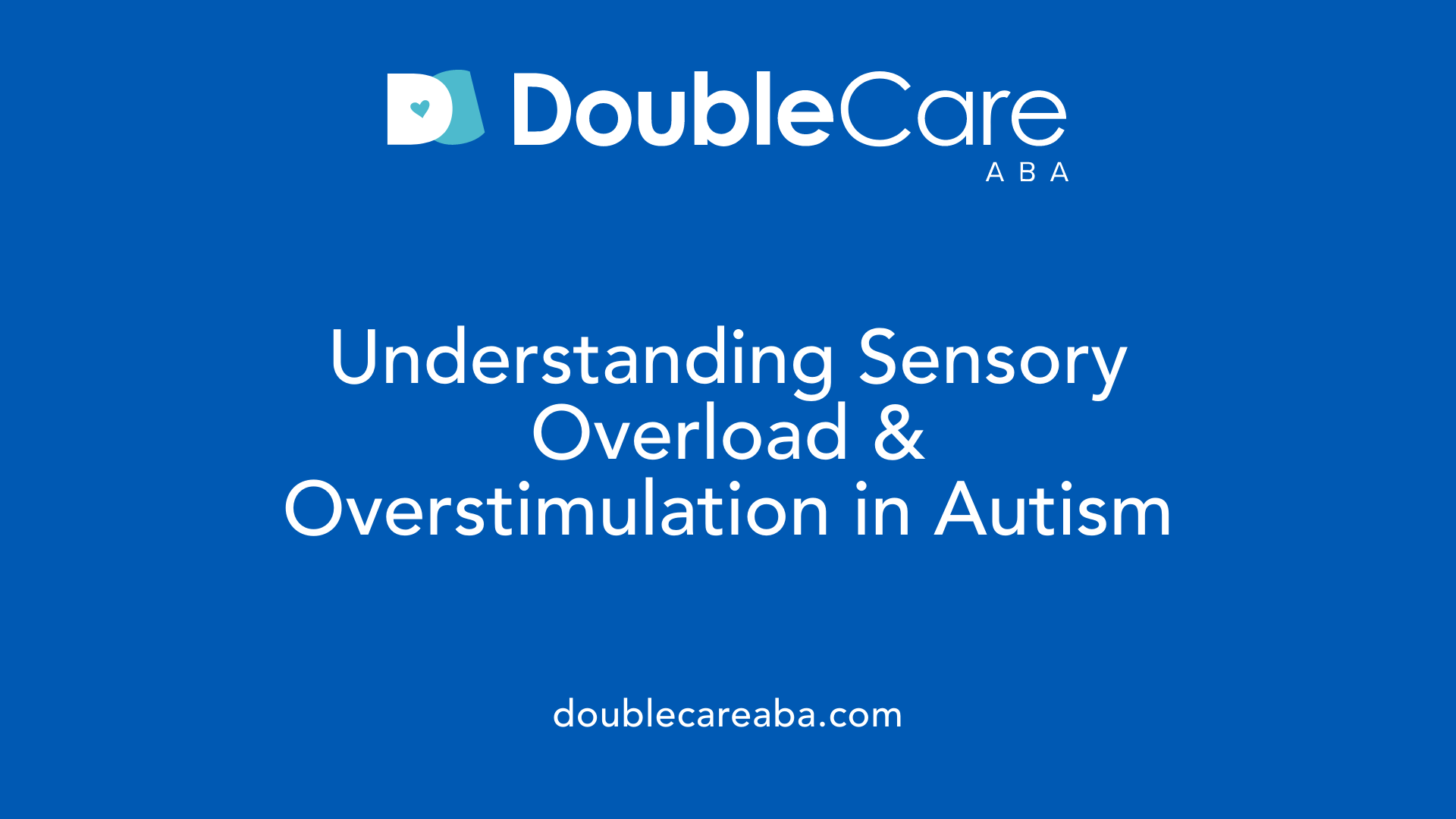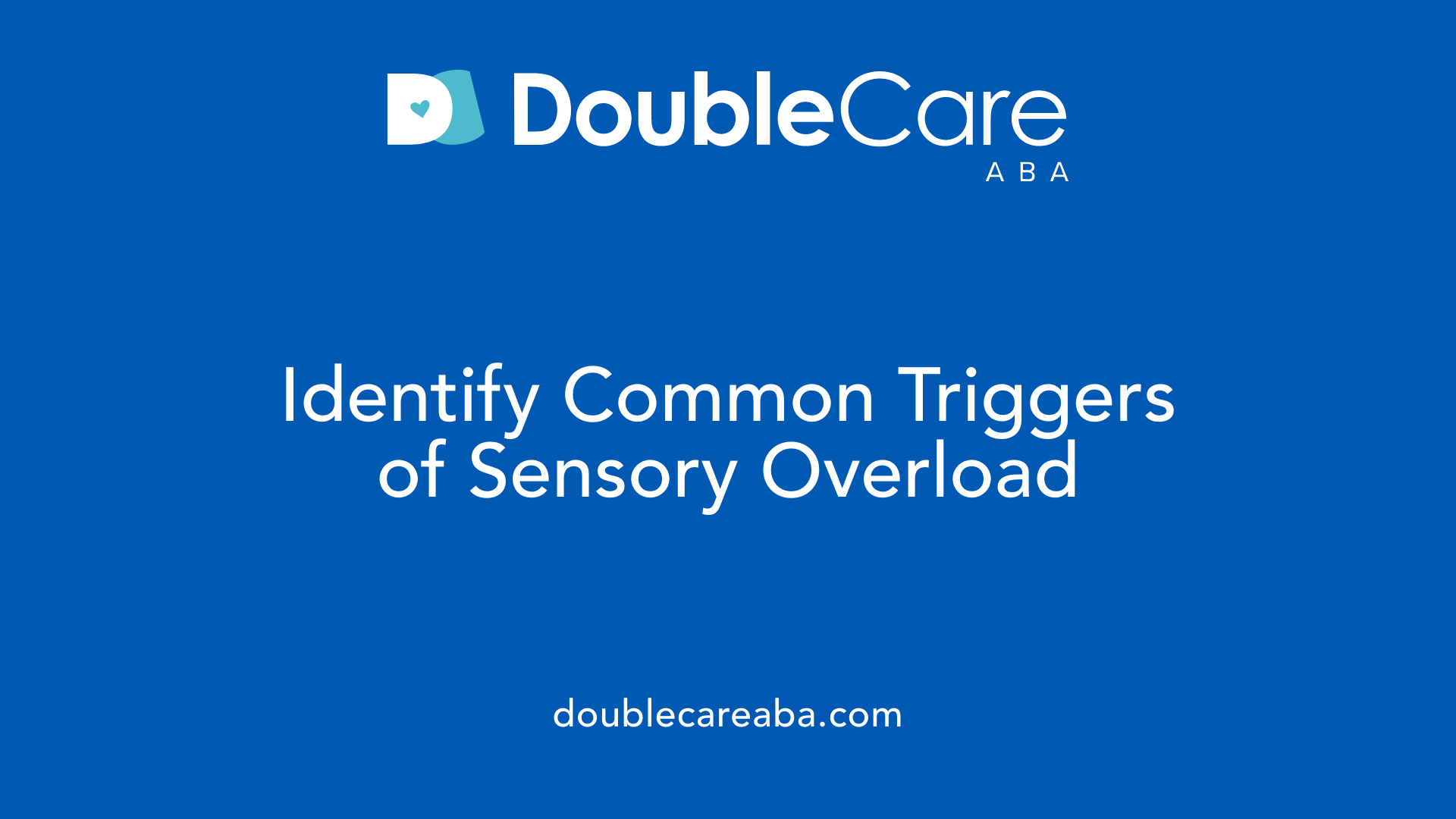An In-depth Look at Sensory Overload and Overstimulation in Autism
Sensory overload and overstimulation are prevalent experiences among autistic individuals, significantly impacting their well-being and daily life. Recognizing what these phenomena entail, their triggers, signs, and management strategies is crucial for fostering understanding and providing effective support. This article explores the complex sensory landscape faced by autistic people, detailing how overstimulation manifests, the conditions that exacerbate it, and practical approaches to mitigate its effects.
Defining Sensory Overload and Overstimulation in Autism

What are sensory overload and overstimulation in autism?
Sensory overload and overstimulation are common experiences for many autistic individuals, caused by an intense influx of sensory information that the brain struggles to process effectively. Sensory overload occurs when the volume or intensity of sights, sounds, smells, tastes, or tactile signals exceeds what the individual can handle comfortably. Overstimulation refers to a similar state where the sensory input becomes overwhelming, often presenting as a flood of sensations that can lead to distress.
In autism, these phenomena happen because the sensory system often processes inputs differently than in neurotypical people. Autistic individuals may be hypersensitive, reacting strongly to stimuli like bright lights or loud noises, or hyposensitive, seeking additional input to meet their sensory needs. This imbalance can make everyday environments—like busy streets or crowded rooms—be overwhelming.
How the autistic sensory system differs from neurotypical processing
Autistic individuals often experience atypical sensory responses. Their brains may have difficulty filtering irrelevant stimuli, leading to a buildup of sensory input that becomes unmanageable quickly. Studies suggest that in autism, there is a weakened ability to habituate or adapt to repetitive stimuli, causing a continuous sense of overload.
This heightened sensitivity activates the amygdala, a brain region involved in stress and fear responses, triggering fight, flight, or freeze reactions. Such responses contribute to behaviors like withdrawal, distress, or meltdowns. Conversely, some may seek additional sensory input, engaging in behaviors like fidgeting or tapping to self-regulate.
What does a sensory overload feel like?
Sensory overload can feel like your senses are overwhelmed by too much input at once. Many describe it as feeling their head is fuzzy or that they are being flooded with sensations. You might experience feelings of anxiety, irritability, or confusion, coupled with physical symptoms such as dizziness, sweating, trembling, or chest tightness.
People often have a strong urge to block out or escape from the stimuli—covering their ears or eyes, fleeing the environment, or engaging in calming routines. It can make communication difficult, as understanding and responding to surroundings become challenging. Overall, sensory overload is distressing and can impact emotional stability.
What does overstimulation in autism feel like?
Overstimulation in autism generally involves an overwhelming flood of sensory input that the brain finds hard to process. It may manifest physically as pain or discomfort, alongside increased anxiety or emotional outbursts. Individuals may seek to block out the stimuli by covering their ears or eyes, or they might try to leave the environment.
This state complicates social interactions and communication, often leading to frustration or withdrawal. Effective management includes creating calm, sensory-friendly spaces, providing tools like noise-canceling headphones, and engaging in sensory integration activities to help ease the overload.
Managing sensory overload and overstimulation
To support individuals experiencing these states, environmental modifications are crucial. Reducing bright lights, loud noises, or visual clutter can help. Using sensory tools such as weighted blankets, fidget toys, or calming music offers additional regulation options.
Building awareness of personal triggers and teaching coping strategies—like deep breathing or scheduled breaks—are essential. Over time, these approaches can improve resilience and help prevent overwhelming episodes.
| Aspect | Description | Additional Info |
|---|---|---|
| Causes | Excess in sensory stimuli, sensory processing differences | Includes bright lights, loud sounds, textures, smells |
| Symptoms | Irritability, covering ears/eyes, pacing, crying | Physical discomfort, rushing thoughts |
| Management | Environmental adjustments, sensory tools, relaxation tech | Environment modifications, skills training |
Understanding these sensory challenges helps foster more supportive environments, improving quality of life for autistic individuals.
Causes and Triggers of Sensory Overload

What are common triggers of sensory overload?
Sensory overload occurs when the brain receives more sensory input than it can process comfortably. For individuals with autism, this condition is especially common and can result from various triggers.
Many of the most frequent triggers include loud noises, such as honking cars or crowded events, which can be overwhelming due to their volume and unpredictability. Bright, flashing, or flickering lights are also significant contributors, particularly in environments like shopping malls or concerts.
Visual visual clutter and busy environments with many moving elements can increase the risk of overload by overloading visual processing systems. Strong smells, whether from perfumes, cleaning supplies, or food, can also overwhelm the senses. Certain textures or tastes in food may cause discomfort or even pain, triggering sensory distress.
It’s important to recognize that internal factors play a role too. Hunger or pain, for example, can heighten sensitivity to external stimuli, making existing stimuli feel even more intense. Similarly, internal cues such as fatigue or discomfort can amplify sensory sensitivity.
Environmental conditions and unexpected changes often catch individuals off guard. Sudden shifts in routine, unfamiliar surroundings, or loud, unpredictable sounds can trigger sensory overload.
People with hypersensitive responses might react by covering their ears, avoiding stimuli, or becoming anxious. Conversely, those with hyposensitive tendencies may seek out intense sensory experiences, such as loud noises or bright lights, to compensate.
Understanding what triggers sensory overload can enable better management. Accommodations like using noise-canceling headphones, adjusting lighting, creating quiet spaces, and offering sensory tools (fidget spinners, weighted blankets) can help reduce these triggers and support individuals in maintaining calm and focus.
Signs and Symptoms of Overstimulation
 Overstimulation and sensory overload manifest in various behavioral, physical, and emotional signs. Recognizing these signs can help in providing timely support and creating a more comfortable environment for autistic individuals.
Overstimulation and sensory overload manifest in various behavioral, physical, and emotional signs. Recognizing these signs can help in providing timely support and creating a more comfortable environment for autistic individuals.
Behavioral signs include actions like covering ears or eyes to block out overwhelming stimuli, pacing back and forth, or fidgeting excessively. These behaviors are often efforts to self-regulate and manage the intensity of sensory input. Additionally, individuals might exhibit increased movement or rapid, or even absent speech, indicating distress.
Physical signs are equally telling. Sweating, flushing of the face, and physical discomfort such as headaches or a racing heart are common indicators. Some individuals may also feel hot, experience trembling, or report a sensation of chest tightness. These symptoms reflect the body’s fight-or-flight response activated by overwhelming stimuli.
Emotional signs include irritability, frustration, or anger, which can escalate into emotional outbursts or meltdowns. Feelings of withdrawal, such as avoiding social situations or retreating into themselves, are also typical responses. During overstimulation, people may become overwhelmed by their emotions, leading to crying, shouting, or shutdowns where they become non-responsive.
What does a sensory overload feel like? Sensory overload feels like your senses are overwhelmed by too much input, making it difficult to process what you're experiencing. You might feel anxious, irritable, confused, or frustrated, and have a strong urge to block out or escape the stimuli. Physically, it can cause dizziness, sweating, shaking, chest tightness, or a racing mind. Many people also experience feelings of panic or safety concerns, especially in noisy or crowded environments. Overall, it is an intense and often distressing sensation that can make you feel emotionally and physically overwhelmed.
What does overstimulation in autism feel like? Overstimulation in autism often feels overwhelming, like an intense flood of sensory input that can be difficult to process and tolerate. Individuals may experience physical discomfort or even pain, along with heightened anxiety, irritability, or emotional distress. Common signs include covering ears or eyes, seeking to block out intense stimuli, or attempting to retreat to calmer environments. This state can make communication and social interaction more challenging, leading to feelings of isolation or frustration.
Understanding these signs allows caregivers, teachers, and support staff to respond appropriately, helping the individual find relief through environmental modifications, quiet spaces, and calming strategies. Early identification and intervention are crucial in reducing stress and preventing escalation into more severe reactions.
Effects of Overstimulation on Daily Functioning

How does sensory overload affect autistic individuals’ daily functioning?
Sensory overload can have a profound impact on the everyday life of autistic people. When overwhelmed by stimuli such as bright lights, loud noises, or strong smells, their sensory processing systems become flooded, leading to feelings of intense stress and discomfort.
This overwhelming experience often results in withdrawal or distressed behaviors, including meltdowns or shutdowns, which can interfere with communication and social interactions. For example, an autistic individual may find it difficult to engage in conversations or participate in social activities during or after an overload.
Routine activities like work, school, or household chores can become challenging. Concentration may worsen, and enjoyment or participation in activities can decrease. Sensory overload also disrupts sleep patterns—many autistic individuals experience difficulty falling asleep or staying asleep due to heightened sensory sensitivities.
To mitigate these effects, environmental adjustments such as dimming lights, reducing background noise, and using sensory tools like noise-canceling headphones or weighted blankets are essential. Creating a sensory-friendly space provides a safe haven to recover and reset.
Overall, sensory overload hampers daily functioning, affecting communication, socialization, task completion, and sleep. Recognizing and supporting sensory needs through tailored strategies is vital to improving quality of life for autistic individuals and helping them engage confidently in daily activities.
Management and Coping Strategies
What strategies can help manage or reduce sensory overload?
Managing sensory overload involves a combination of environmental adjustments, personal coping tools, relaxation techniques, and support from professionals. Creating a calm, predictable space by reducing excessive sensory input can greatly help. This might include dimming lights, lowering noise levels, and minimizing visual clutter.
Using sensory tools such as weighted blankets, fidget toys, earplugs, or sunglasses can help individuals self-soothe and regain control during overwhelming moments. These tools provide tactile or auditory input that can block or regulate intense sensations.
Relaxation techniques are effective in building resilience over time. Regular practice of deep breathing exercises, such as the 3-3-3 method (inhale for 3 seconds, hold for 3 seconds, exhale for 3 seconds), mindfulness, and guided imagery can calm the nervous system.
Planning and routine adjustments play a critical role. Recognizing personal triggers, like loud noises or bright lights, and preparing ahead—whether by choosing quieter environments or scheduling breaks—can prevent overload.
Seeking professional support adds an important layer of assistance. Occupational therapists can recommend sensory integration techniques and tools suited specifically to an individual’s needs. Cognitive behavioral therapy (CBT) and other therapies can also help develop coping skills and improve adaptive responses.
By combining these strategies, individuals with autism can better manage sensory overload, maintain emotional well-being, and navigate daily environments with greater ease.
Supporting Autistic Individuals During Overload
How can caregivers support individuals experiencing sensory overload?
Supporting autistic individuals during sensory overload involves a combination of understanding, patience, and practical strategies. Recognizing early signs such as covering ears, withdrawal, or signs of agitation allows caregivers to take prompt action.
Creating a sensory-friendly environment is crucial. This includes establishing quiet, dimly lit spaces where the individual can retreat to reduce stimuli. Providing sensory tools such as fidget toys, noise-canceling headphones, or weighted blankets can help manage sensory input and promote calmness.
Implementing personalized sensory routines, like sensory diets or visual schedules, encourages self-regulation and pre-emptively reduces the risk of overwhelm. Clear, simple communication is also vital—asking the person about their needs or preferred ways of interaction, and respecting their boundaries, supports effective coping.
Education plays a significant role. Caregivers should learn about sensory processing and overload signs to better advocate and adapt environments accordingly. Supporting long-term resilience involves not only immediate response strategies but also promoting an understanding environment that values individual sensory needs.
In essence, patience, preparedness, and respect for each person's unique sensory profile help to navigate episodes of overload safely and compassionately.
Creating Sensory-Friendly Environments and Supports

How can environmental modifications help individuals with sensory sensitivities?
Creating a sensory-friendly space is vital for supporting autistic individuals who are sensitive to lights, sounds, textures, and smells. Adjustments such as dimming bright lights or using softer lighting can reduce visual overstimulation. Soundproofing or using noise-canceling devices can help manage loud or disruptive noises that may cause stress or overload.
What tools and spaces can promote calmness?
Using sensory tools like fidget toys, weighted blankets, or textured objects provides comfort and helps individuals self-regulate. Designating quiet zones or calm rooms offers a refuge during sensory overload, enabling quick recovery and minimizing distress.
How do visual supports and schedules aid in sensory management?
Visual supports, including picture schedules and visual timers, prepare individuals for upcoming activities and reduce surprises that can trigger overstimulation. Clear, predictable routines help create a sense of security and control, which can lessen anxiety and sensory overload.
Why is routine and predictability important?
Consistency in daily routines helps individuals anticipate sensory experiences, reducing uncertainty and stress. Planning activities and transitions with notice and structure encourages a more manageable environment, promoting well-being and effective coping.
| Modifications | Tools & Spaces | Supports & Schedules | Benefits |
|---|---|---|---|
| Adjust lighting | Fidget toys | Visual timetables | Reduced sensory overload |
| Soundproofing | Weighted blankets | Routines and predictability | Increased comfort and coping ability |
| Sensory mats | Calm rooms | Visual supports | Decreased anxiety and meltdowns |
| Texture considerations | Noise-canceling headphones | Structured transitions | Enhanced sensory regulation for individuals with autism. |
Long-term Approaches to Managing Sensory Overload
Building resilience through gradual exposure
Developing tolerance to sensory stimuli can be a helpful long-term strategy. Gradual exposure to sensory inputs in controlled environments allows autistic individuals to build resilience over time. This approach, often guided by occupational therapists, involves slowly introducing stimuli like sounds, textures, or lights while ensuring the person feels safe and supported.
Communication about sensory needs
Empowering individuals to communicate their sensory preferences and thresholds is essential. Using visual supports, social stories, or cues can help autistic people express when they need sensory breaks or adjustments. Clear communication reduces anxiety and helps manage overload before it occurs.
Advocacy and environmental adjustments
Creating sensory-friendly spaces at home, school, or work can significantly reduce overload risk. Adjustments like dimmer lights, noise-canceling devices, or quiet zones help accommodate sensitivities. Advocating for these modifications with caregivers, educators, and employers ensures that sensory needs are respected and met consistently.
Therapies and interventions
Evidence-based therapies such as occupational therapy focusing on sensory integration techniques and cognitive behavioral therapy (CBT) can teach self-regulation strategies. These interventions help individuals recognize early signs of overload, employ coping mechanisms, and develop confidence in managing their sensory environment.
Implementing these long-term strategies supports autistic individuals in leading more comfortable and balanced lives, promoting resilience and independence.
The Journey Towards Better Sensory Understanding
Recognizing and respecting the sensory sensitivities of autistic individuals is vital for their well-being. Through a combination of personalized strategies, environmental modifications, and ongoing support, it is possible to reduce the frequency and severity of sensory overload episodes. Empowering autistic individuals with knowledge and practical tools not only improves their daily life but also fosters greater inclusion and understanding. As society continues to learn about sensory processing differences, compassion and adaptation remain key in creating a more accessible world for everyone.
References
- Sensory issues - Autism Speaks
- What is sensory overload? What you need to know
- Sensory differences - a guide for all audiences
- Four Faces of Overstimulation - Autism Spectrum News
- Overstimulation in Autism: Why it Happens & How to Respond
- Autism Overstimulation And Sensory Overload - Simply Psychology
- Understanding Overstimulation in Autism
- How To Manage (and Even Overcome) Sensory Overload















